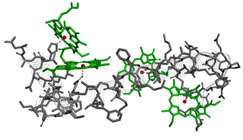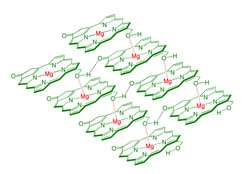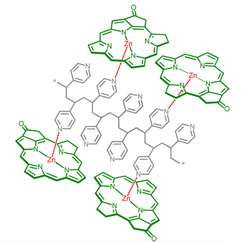Chlorophyll harnessed for use in nanophotonic applications

Researchers from Aalto University and the University of Helsinki are developing nanostructures in which chlorophylls are bound to synthetic materials. Chlorophyll is a true gift of nature to photonics, as it absorbs the wavelengths of blue and red colour from sunlight very efficiently.
The research project utilises chlorophyll extracted from green plants. Docent Juho Helaja's research group at the University of Helsinki has extracted chlorophyll from such sources as spinach and cyanobacteria.
Chlorophylls require tailoring
It is not enough to merely extract chlorophyll molecules and place them in a test tube. It is essential to tailor molecules, i.e. modify them chemically into such a form that their functionality can be utilised in a non-biological environment. Doctoral Candidate Taru Nikkonen from the Department of Chemistry of the University of Helsinki is responsible for the extraction of chlorophyll derivatives from natural materials, as well as their synthetic modification.
The properties of modified chlorophylls can be controlled by altering the pigments' volume and concentration in polymer matrices. The interaction between the molecules is dependent on the distance between molecules, which has a great influence on excitation dynamics of the molecules.
A drop in a bucket
'If molecules are too close to one another, the absorbed energy is able to spread between them very easily, much in the same way as the waves caused by a drop of water falling into a bucket of water die away in the larger water mass. Additionally, molecules have the tendency to aggregate i.e. gather into dense clusters, if they are not bound to polymers', Professor Ilkka Tittonen from Aalto University's Department of Micro and Nanosciences explains.

The researchers have successfully identified how light response alters as molecule density increases in structures in which molecules are bound to polymers with noncovalent bonds. The benefits of this type of solution include structural diversity, inexpensive price, ease of production and strong sensitivity to light stimulus. In addition, the positioning of molecules can be optimised to maximize the collection of the absorbed light.
A long-lasting raw material for organic electronics
Functional materials and nanophotonics offer possible application options for structures based on chlorophylls. These could be used for instance in organic solar cells, LEDs and lasers. For example, a solar cell manufactured from this type of material would be able to function even on cloudy days.
'Chlorophyll is a nearly infinite raw material. It is the world's most abundant pigment measured by biomass. Also, there is no need for excessive amounts of material: as only a few micrograms of chlorophyll is needed to produce a thin film with the surface area of a postage stamp', Doctoral Candidate Ville Pale estimates.

Nature an infinite source of inspiration
'All life on Earth is based on the photosynthesis of plants, in which chlorophyll plays a key role. It cannot be a very poor starting point for research if you seek ideas from such a perfectly functioning process', Professor Tittonen says.
Applying biological methods and chemical reactions that take place in nature to the research and development of technology is called biomimetics. Complicated mechanisms developed by nature arouse astonishment in many researchers.
'Nature has had 5 billion years to develop structures and systems that people can only dream of duplicating', Mr Pale sums up.
An article written by the researchers' and published in the Journal of Materials Chemistry will be accessible to the general public until 3 September.
More information: pubs.rsc.org/en/content/articl … f/2013/tc/c3tc00499f
Journal information: Journal of Materials Chemistry
Provided by Aalto University

















